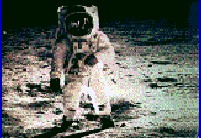
Humans in Space
Copyright © 1997 by Dava J. Newman. All rights reserved.
No material from this web site may be reproduced, distributed, or transmitted, in any form or by any means, or stored in a database or retrieval system.
This section includes the following:
 History of Spacesuits
History of Spacesuits
 Life Support Systems
Life Support Systems
 Extra Vehicular Activity
Extra Vehicular Activity
 Virtual Spacewalk (Stephen Maher, Goddard Space Flight Center)
Virtual Spacewalk (Stephen Maher, Goddard Space Flight Center)
 Special Classroom Projects
Special Classroom Projects
Life Support Systems
Life support is the maintenance of a life form's
natural functions in a hostile environment where life simply
cannot sustain itself. Mankind's journeys have taken people
to the harsh environment of space and the upper atmosphere,
where life support is crucial and complex. Here humans combat
extreme temperatures, dangerous radiation, and the breathless
vacuum of space.
Artificial Atmospheres
The most crucial element of life support in space is a breathable
atmosphere. A human in space, whether in a craft, station, or
suit, must have air. Choosing the composition of an artificial
atmosphere, however, is difficult. The table below shows
atmospheric mixes for various stages of the American space
program.
Table of Atmospheric Concentrations
Atmosphere of Pressure Oxygen Nitrogen Comments
Earth 14.7 psi 21% 78% Traces of other gases
Early space
capsules 5 psi 100% 0% Mercury, Gemini, Apollo
Skylab 5 psi 70% 30% First space station, 1973
Space shuttles 14.7 psi 20% 80% Closest to Earth's
U.S. spacesuit 4.3 psi 100% 0% Present-day; used for EVA's*
* Extra Vehicular Activities
Physiological, engineering, cost, and safety factors must be
considered when designing artificial atmospheres. Physiologically, an
atmospheric mixture of nitrogen and very little oxygen can
promote hypoxia. Excessive amounts of oxygen
will prompt the
opposite condition, hyperoxia. Incorrect
concentrations can
also cause hypercapnia, an abnormal increase of carbon dioxide
in the blood, or even altitude decompression
sickness (ADS). If
sufficient forced ventilation is provided, such problems are
alleviated or prevented.
The importance of the safety factor was tragically emphasized
when during a test on the launch pad, Apollo 1 caught fire. An
electrical short ignited the oxygen-rich air. All three crew
members were killed.
Plans for the International Space
Station demonstrate the
engineering required for artificial atmospheres and related systems.
Six systems under development include fire detection and
suppression, atmosphere revitalization, temperature and humidity
control, atmosphere control and supply, waste management, and
water recovery systems. All systems, whether involving the air
supply or not, must meet limited weight, power, and reliability
requirements.
Spacesuits

Spacesuits must meet stringent requirements for life support. The suit
has to be of durable material to withstand the impact of
space debris and protect against radiation. It must provide
essential oxygen, pressure, heating, and cooling, while retaining
mobility and dexterity. The design requirements for suits
are indeed impressive and complex, yet both Russian and American
space programs have succeeded in developing functional suits.
Today, American astronauts performing extra vehicular activities
use a spacesuit containing 100% oxygen at a pressure of 4.3 psi.
However, with such a high oxygen concentration, astronauts
reentering the shuttle sometimes suffer from decompression sickness,
simliar to what ocean divers experience after returning to the
surface too quickly. To prevent such problems, the cabin
pressure is reduced to 10.2 psi for a limited time. The Russian
spacesuit, like the American, uses a liquid cooling garment to
control body temperature. It uses, however, a suit pressure of 5.6 psi
and requires the cosmonaut to take a 30 minute prebreath to adjust
to the new pressure.
Life support via an American spacesuit relies on three main
systems: the Life Support System (LSS),
the space suit
assembly, and additional supporting equipment. The
LSS contains
the following:
- Primary Life Support Subsystem (PLSS)
-
- a self-contained portable life support backpack mounted on the
hard upper torso (HUT) section of the
spacesuit
- contains everything necessary to maintain life and
communication.
-
The Lithium Hydroxide Cartage
-
- removes contaminates and carbon dioxide from ventilation gases.
-
The Display and Control Module (DCM),
-
- mounted on the front of the HUT, it
provides easy access to suit
controls.
-
The Secondary Oxygen Pack (SOP)
-
- a thirty minute emergency oxygen supply
-
Battery
-
- powers the electrical systems stored in the
PLSS; easily
replaceable.
The space suit assembly uses bearings for movement and includes
the units listed below:
- Helmet/Visor Assembly
-
- Made of polycarbonate material, it protects against radiation
and controls the direction of ventilation.
- It connects to the HUT and has
mounting brackets for lights and
cameras.
-
Hard Upper Torso (HUT)
-
- Of fiberglass construction, it provides for mounting all
components of the extravehicular mobility unit.
-
Lower Torso Assembly (LTA)
-
- Lower body seal closure pants and boots, with a polyurethane
bladder for pressure maintenance
- permits joint movements and rotation
-
Gloves
-
- protects the astronaut's hands and is jointed
- gives crew member enough dexterity to work with tools
-
Arms
-
- connects to HUT and gloves; has elbow
joint for flexibility
-
Comm Cap
-
- fabric cap fitted with a microphone and earphone to permit
communication
-
Liquid Cooling Ventilation Garment (LCVG)
-
- A jump suit containing water cooling tubes to keep body
temperatures level
-
Urine Collection Device/Disposable Absorption Containment Trunk
-
- absorbs urine to keep skin dry, single use and disposable
- available for both the male and female astronaut.
-
Thermal Meteoroid Garment (TMG)
-
- consisting of several layers, the innermost layer is made of
neoprene-coated rip-stop nylon for puncture and tear protection
- the middle layers are thermal insulators made of aluminum mylar
- the outer layer, made of a woven blend of Kevlar and nomex
synthetic fibers, is white to reflect sunlight and teflon-coated
to say clean; especially resistant to tears, punctures, and
abrasions.
The equipment that supports both the Life Support System and the
suit assembly includes tools used to repair, maintain, and
prepare the suit, astronaut, and manned maneuvering unit for an
EVA.
A spacesuit in development is the
Command/Control Pressure Suit
(CCPS). This design combines the helmet and
HUT into a rigid
upper torso/helmet. Using a multifaceted structure, the design
uses flat panes instead of the current bubble shape. A
video/data liquid crystal display mounted in the helmet controls
suit functions and runs on voice commands.
Class Discussion
- What other problems do people have in surviving the harsh and
beautiful environment of space?
- Why do you need forced ventilation aboard a space vehicle?
- Discuss an overall design for a spacesuit. What are the
problems? What kind of material would you use?
Activities and Research
Make a spacesuit designed and built by the class.
a. Discuss an overall design.
b. Decide what major components are important to a space suit
c. Divide the class into groups and assign a component or
components to a group. Have each group design their own version
of the item(s) assigned.
d. Have the groups build their designs
e. Have the groups present their designs to the class as if
marketing a product at a business meeting.
f. Have the groups attempt to integrate their designs into one
whole spacesuit.
g. Discuss the problems with integration of various groups
Research
- What are the similarities and differences between a scuba diver
and an astronaut, especially concerning decompression sickness?
For the values listed in the Table of Atmospheric Conditions, in
which atmosphere or atmospheres could a person suffer
decompression sickness?
- A Soviet cosmonaut was stranded aboard Mir, the Soviet, now
Russian, space station during the collapse of the Soviet Union.
What kind of spacesuit did he have available aboard Mir?
- Research and report to the class on the different spacesuits
used by NASA through the years of the space program
- Research and report to the class on Russian spacesuits
- Compare the number of astronauts who have died in a
space-related accident with the total number of astronauts and
with the total number of manned launches. Compare the first
number with researched calculated probabilities. Is the number
of disasters high, or low?
Problems
- What is the composition of Earth's atmosphere, beyond oxygen and
nitrogen gases? What gases are there traces of in the
atmosphere? Has the composition of the atmosphere changed
significantly over time, according available records? Are there
available records?
- Convert all pressures listed in the Table of Atmospheric
Conditions to atmospheric units. Earth should have a pressure
of one atmosphere.
 History of Spacesuits
History of Spacesuits
 Life Support Systems
Life Support Systems
 Extra Vehicular Activity
Extra Vehicular Activity
 Virtual Spacewalk (Stephen Maher, Goddard Space Flight Center)
Virtual Spacewalk (Stephen Maher, Goddard Space Flight Center)
 Special Classroom Projects
Special Classroom Projects

 History of Spacesuits
History of Spacesuits
 Life Support Systems
Life Support Systems
 Extra Vehicular Activity
Extra Vehicular Activity
 Virtual Spacewalk (Stephen Maher, Goddard Space Flight Center)
Virtual Spacewalk (Stephen Maher, Goddard Space Flight Center)
 Special Classroom Projects
Special Classroom Projects
